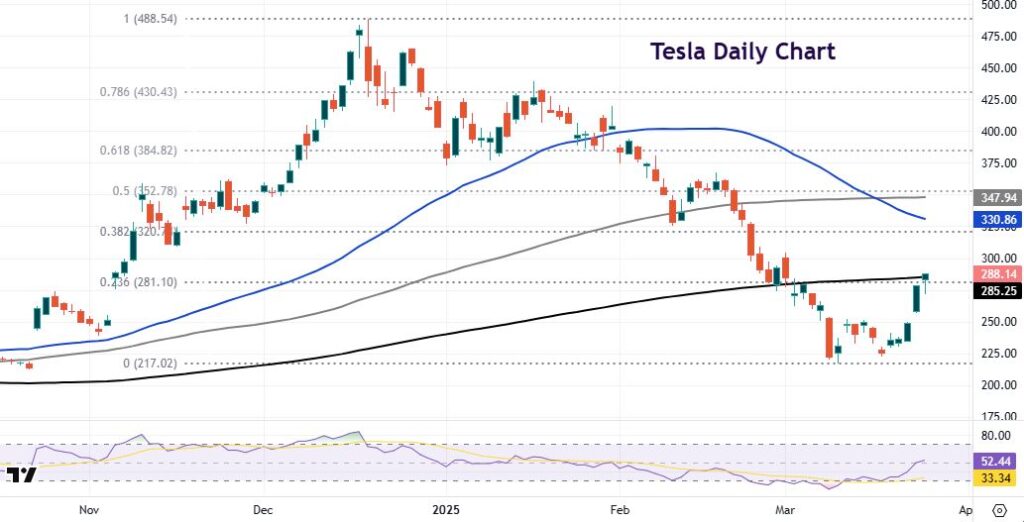Markets mixed on soft US consumer confidence

- US says Ukraine, Russia agree to ensure safe navigation in Black Sea
- Dollar choppy on economic data and tariff uncertainty
- Tech leads gains in stocks but indices waver after Monday rally
- Gold rises on haven demand amid Trump levy worries
FX: USD paused its rally with the first down day in five. Treasury yields turned lower on falling consumer confidence figures. It was the fourth straight month of deteriorating sentiment and hit a four-year low. Again, we had mixed tariff messages which suggests continued disagreement in the Trump administration.
EUR sold off for a fifth day in a row. Germany’s IFO business data was in line with estimates. This followed the better PMI numbers pointing to potential improvement in Germany’s economic outlook. Breaks of US (auto) tariffs would be important, though questions are also being asked about how quickly the recently agreed German fiscal package will impact the economy.
GBP printed higher for a second day as prices remained above 1.29. Tariff relief is being actively sought by the UK government. We get UK CPI data and the finance minister’s spring update today.
USD/JPY moved down after topping out at 150.94. The US 10-year Treasury yield failed again to push decisively above 4.34%. This yield has a high correlation to this currency major. We note the 50-day SMA has crossed below the 200-day SMA potentially pointing to a “death cross” around 151.50/68.
AUD outperformed as the government unveiled surprise tax cuts in the budget. Prices continue to trade around the 50-day SMA at 0.6291. USD/CAD fell back to a major Fib level at 1.4268. All eyes are obviously on tariffs. President Trump said that sectoral tariffs could be announced shortly (i.e. before reciprocal tariffs). But he later said that he might give “a lot of countries” breaks on tariffs.
US stocks: The S&P 500 gained 0.16% to settle at 5,777. The tech-heavy Nasdaq finished up 0.53% at 20,288. The Dow added 0.01% to close at 42,588. Communication services and consumer discretionary led the gainers, with utilities the worst performing sector as defensives heavily underperformed. Consumer confidence disappointed but there was positive rhetoric from Russia/Ukraine talks with a maritime ceasefire agreed.
Asian stocks: Futures are mixed.APAC stocks also traded mixed on Tuesday after the early momentum from the tariff-related optimism Stateside wore thin. The ASX 200 advanced at the open but then gave back most of its gains after stalling near the 8,000 level. The index has rebounded from a low in mid-March 7,725. The Nikkei 225 briefly climbed above the 38,000 level but pulled back from intraday highs with recent currency moves influencing price action. The Hang Seng and Shanghai Comp were pressured with underperformance in Hong Kong as tech and auto names lost traction amid recent earnings releases and tariff risk.
Gold found a bid though gave back most of its gains having spiked higher after disappointing US economic data. Treasury yields moved lower as well as the dollar.
Day Ahead – Australia CPI, UK CPI and Spring Statement
Australia releases CPI data for February, with consensus looking at a third consecutive 2.5% y/y headline print. The trimmed mean re-accelerated in January from 2.7% to 2.8%, causing potential trouble for the RBA, which started easing last month. Some new disinflationary signs are needed to likely convince markets to fully price back a cut by May. That said, the RBA is a secondary driver for AUD compared to tariff news and global risk sentiment.
Analysts forecast the UK headline inflation rate to cool one-tenth to 2.9%. The core is also seen off one-tenth at 3.6% but services is predicted to tick up to 5.1%, matching the MPC estimate. The next BoE rate cut isn’t seen until the summer, according to money markets.
UK Chancellor Reeves will be under the spotlight with the release of the Spring budget Statement. She will likely need to find some savings due to a rise in debt interest costs. Spending cuts should be enough to meet the fiscal rule. Bond markets will be wary, with the ghost of former PM Truss to the fore. Any major repricing lower in growth expectations will hit the pound.
Chart of the Day – Tesla bounces back to the 200-day SMA
Tesla has been a lot of headlines recently. Sales in Europe tumbled 47% in February marking a second straight month of sharp declines. That compares with a 31% increase in industry-wide EV registrations. The lack of new models and Elon Musk’s politicalisation have put off would-be and existing owners, as the stock sunk to prices last seen before the November US election at $217.02. But Musk told Tesla employees not to sell shares on Monday, while Trump administration officials have said similar. Indeed, JP Morgan reported that retail traders poured $8.1bn into Tesla stock over 13 straight trading days. That’s the biggest retail buying streak by dollar amount in more than 10 years.
The stock price closed 12% higher on Monday, its best session since the near-15% jump on November 6, the day after Trump’s election victory. We are now back above the first Fib retracement level (23.6%) at $281.10. The 200-day SMA sits at $285.25. The next upside mark will be the major Fib level (38.2%) at $320.74.


